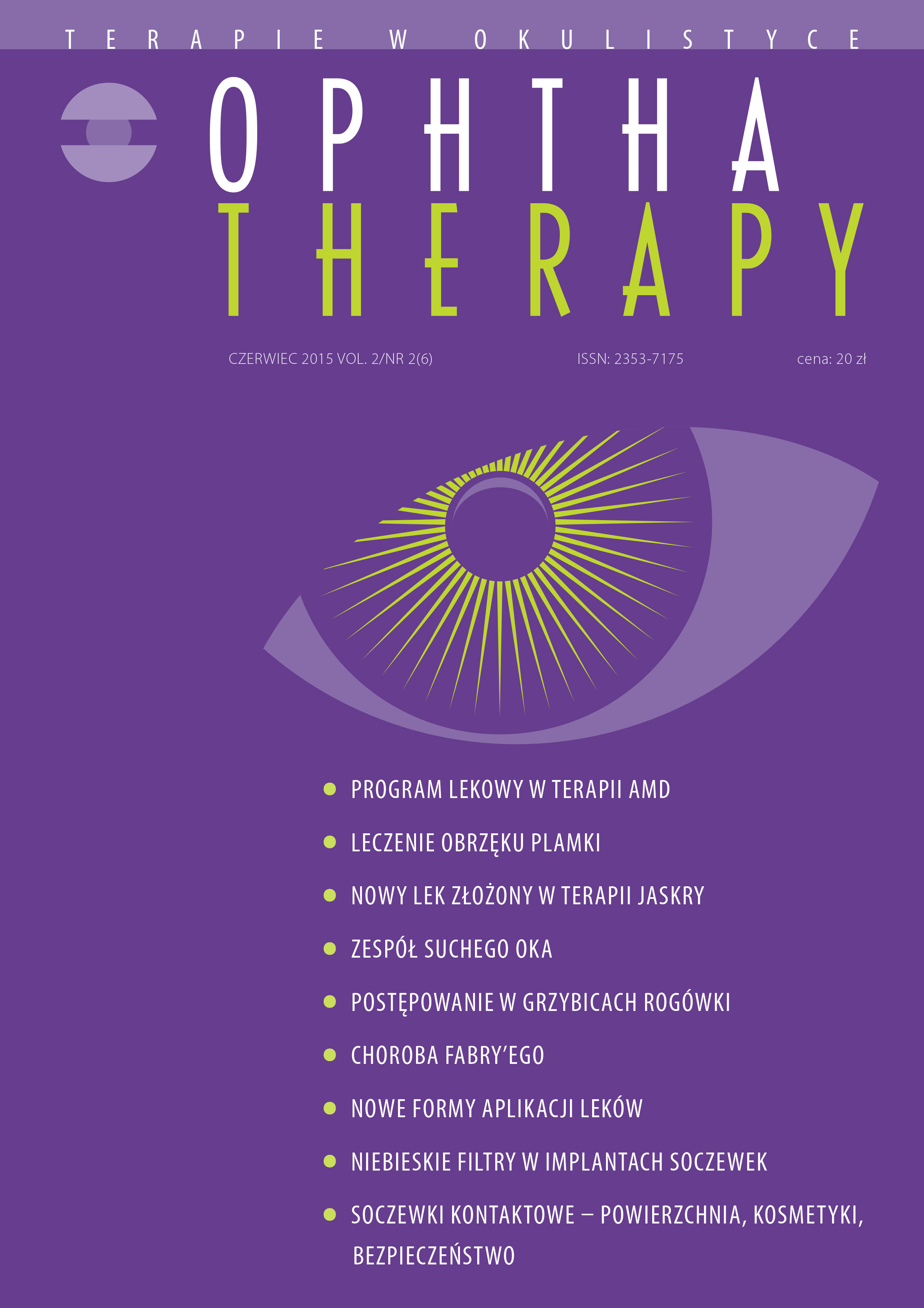Grzybicze zapalenie rogówki
##plugins.themes.bootstrap3.article.main##
Abstrakt
Grzybicze zapalenie rogówki jest dość rzadko spotykane w umiarkowanych strefach klimatycznych. Najczęstszymi patogenami grzybiczymi są mikroorganizmy z grupy Aspergillus, następnie Fusarium i Penicilium. Patogeny grzybicze docierają do istoty właściwej rogówki przez uszkodzony nabłonek i namnażają się, powodując martwicę tkanek i silną reakcję zapalną. W diagnostyce grzybiczych infekcji rogówki przed włączeniem leczenia przeciwgrzybiczego należy pobrać materiał tkankowy (zeskrobiny rogówkowe) do badań. Leczenie jest trudne, ok. 30% grzybiczych infekcji rogówki nie odpowiada na farmakoterapię i może grozić perforacją rogówki. Konieczny jest wtedy leczniczy drążący przeszczep rogówki, który powinien zostać wykonany w ciągu 4 tygodni od początku choroby.
Pobrania
##plugins.themes.bootstrap3.article.details##

Utwór dostępny jest na licencji Creative Commons Uznanie autorstwa – Użycie niekomercyjne – Bez utworów zależnych 4.0 Międzynarodowe.
Copyright: © Medical Education sp. z o.o. License allowing third parties to copy and redistribute the material in any medium or format and to remix, transform, and build upon the material, provided the original work is properly cited and states its license.
Address reprint requests to: Medical Education, Marcin Kuźma (marcin.kuzma@mededu.pl)
Bibliografia
2. Wong T, Fong K, Tan D. Risk factors and clinical outcomes between fungal and bacterial keratitis: a comparative study. CLAO J. 1997; 23: 275-81.
3. Johns K, O’Day D. Pharmacologic management of keratomycoses. Surv Ophthalmol. 1988; 33(3): 178-88.
4. Thomas P. Fungal infection of the cornea. Eye. 2003; 17(8): 852-62.
5. Velez M, Balparda K, Diaz A. A rare pigmented keratitis caused by Aspergillus fumigatus. Int J Ophthalmol. 2015; 8(1): 208-10.
6. Srinivasan M, Gonzales C, George C. Epidemiology and aetiological diagnosis of corneal ulceration in Madurai, south India. Br J Ophthalmol. 1997; 81(11): 965-71.
7. Zagórski Z, Naumann G, Watson P. Choroby rogówki, twardówki i powierzchni oka. Wydanie I. Wydawnictwo Czelej, Lublin 2008: 232-6.
8. Vaddavalli P, Garg P, Sharma S et al. Role of confocal microscopy in the diagnosis of fungal and acanthamoeba keratitis. Ophthalmol. 2011; 118(1): 29-35.
9. Avunduk A, Beuermann R, Varnell E et al. Confocal microscopy of Aspergillus fumigatus keratitis. Br J Ophthalmol. 2003; 87(4): 409-10.
10. Jaeger E, Carroll N, Chouhury S et al. Rapid detection and identification of Candida, Aspergillus, and Fusarium species in ocular samples using nested PCR. J Clin Microbiol. 2000; 38(8): 2902-8.
11. Xie L, Dong X, Shi W. Treatment of fungal keratitis by penetrating keratoplasty. Br J Ophthalmol. 2001; 85: 1070-4.
12. Prost M, Jachowicz R, Nowak J (ed.). Kliniczna Farmakologia Okulistyczna. Wydanie I. Elsevier Urban & Partner, Wrocław 2013: 149-55, 427-9.
13. Yilmaz S, Maden A. Severe fungal keratitis treated with subconjunctival fluconazole. Am J Ophthalmol. 2005; 140(3): 454-8.
14. Mahdy R, Nada W, Wageh M. Topical amphotericin B and subconjunctival injection of fluconazole (combination therapy) versus topical amphotericin B (monotherapy) in treatment of keratomycosis. J Ocul Pharmacol Ther. 2010; 26(3): 281-5.
15. Haddad R, El-Mollayess G. Combination of Intracameral and Intrastromal Voriconazole in the Treatment of Recalcitrant Acremonium Fungal Keratitis. Middle East Afr J Ophthalmol. 2012; 19(2):265-8
16. Sharma N, Agarwal P, Sinha R. Evaluation of intrastromal voriconazole injection in recalcitrant deep fungal keratitis: case series. Br J Ophthalmol. 2011; 95: 1735-7.
17. Niki M, Eguchi H, Hayashi Y. Ineffectiveness of intrastromal voriconazole for filamentous fungal keratitis. Clin Ophthalmol. 2014; 8: 1075-9.
18. Makdoumi K, Mortensen J, Crafoord S. Infectious keratitis treated with corneal crosslinking. Cornea. 2010; 29(12): 1353-8.
19. Vazirani J, Vaddavalli P. Cross-linking for microbial keratitis. Indian J Ophthalmol. 2013; 61(8): 441-4.
20. Ismaiel A, Tharwat N. Antifungal activity of silver ion on ultrastructure and production of aflatoxin B1 and patulin by two mycotoxigenic strains, Aspergillus flavus OC1 and Penicillium vulpinum CM1. J Mycol Med. 2014; 24(3): 193-204.
21. Panda A, Vajpayee R, Sankar Kumar T. Critical evaluation of therapeutic keratoplasty in keratomycosis. Ann Ophthalmol. 1991; 23: 373-6.

